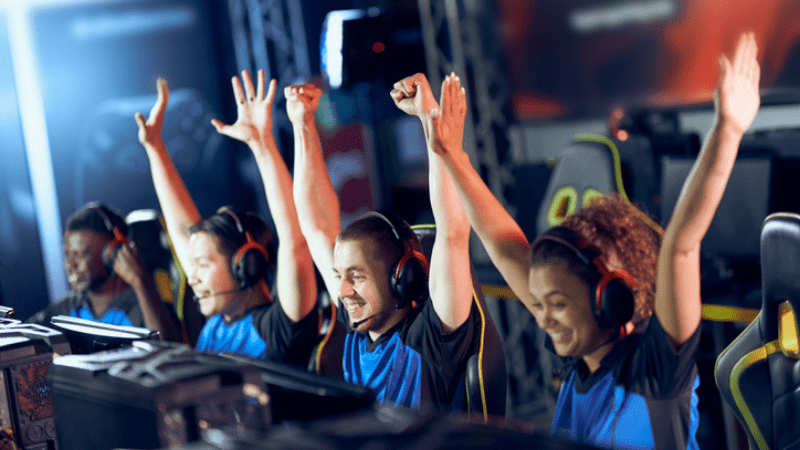Have you ever wondered how to start an esports club at school? When Eagles Landing Middle School Principal Joe Peccia reflects on launching his school’s esports team, the first thing he recalls is the positive impact it had on disengaged students. Nearly 1/3 of the students on Eagles Landing Middle School’s esports teams were previously uninvolved in school clubs or extracurricular activities. After the school started its esports club, they proudly wear Eagles Landing jerseys.
“Esports gives kids an opportunity to compete and feel like an important part of the schools,” says Peccia. “It doesn’t matter what color, height, weight, or gender someone is. They can just be who they are—and when the scores from their matches come out and get announced during our announcements, watching those kids feel like they’re seven feet tall is the greatest thing in the world.”
More than 3400 high schools are part of Generation Esports’ High School Sports Leagues, and middle school esports teams are increasingly common. These players may eventually have the opportunity to play at the collegiate level since more than 170 US colleges have varsity esports programs and are offering around $16 million per year in scholarships.
Getting started isn’t as complicated as you may think. Here’s how to start an esports club at your school:
1. Find interested students and staff
You already have gamers in your building. You just need to find them. Baro Hyun, author of Demystifying Esports: A Personal Guide to the History and Future of Competitive Gaming knows how to do this easily.
“One way to find gamers is to organize an in-school esports tournament event,” Hyun says. “They will definitely show up.”
The “tournament event” doesn’t have to be elaborate. In fact, it could be as simple as Mario Kart races on student-owned handheld devices in the school cafeteria. You may even be able to find a student or staff member to help you plan and organize an initial event.
When Peccia was starting his school’s esports club, he put the word out to students and staff. “Reach out to all your staff members – not just your teachers—to find out who has an interest in video games or esports,” he says. “It will surprise you, who has an interest.” Peccia isn’t wrong. A 2018 study conducted by the Pew Research Center indicated that 97% of boys and 83% of girls ages 13-17 identify as gamers.
When you’ve gathered a group, it’s time to figure out who’s interested in which games. Eagles Landing Middle School currently has five different teams: one plays Rocket League; one, Mario Kart; another, Super Smash Brothers; and another, Minecraft. Another team is training to play a NASCAR racing game.
Note: Coaches do not need to have gaming experience (though it’s certainly helpful!). The head coach of one successful Korean professional esports team is a former boxer with no gaming experience, Hyun says, noting that esports coaching is really “about teaching the soft skill sets—communication, collaboration, strategic thinking, ad-hoc coordination, leadership, and dedication.”
2. Reach out for help
Got a local college? There’s a good chance they have an esports program. (More than 175 United States colleges and universities have varsity esports, and hundreds more have esports teams.) Peccia called Keiser University in West Palm Beach; their esports coach was “fantastic in getting us support and helping us create a vision of how an esports program should look.” Universities with esports teams may also be willing to allow your students to use their equipment a few hours per week. “That’s a great recruiting opportunity for that university,” says Neal Doolin, a former high school esports coach who now works with Generation Esports.
The National Esports Association is also a good source of support, including nuts and bolts info about how to set up games, create tournaments, and coach students.
3. Gear up
You don’t have to spend a lot of money when you’re planning how to start an esports club at school.
Begin by identifying the games your students want to play; there’s no sense in purchasing a bunch of Xboxes or PlayStations if your students want to play Overwatch, Rocket League, or Super Smash Brothers, as those games are usually played on personal computers.
Check the game specifications. “You really need to understand the games you’re utilizing and what it takes to have them work at an optimal level,” Peccia says. “In esports, it’s all about frame rate and speed. You do not want to be one millisecond behind someone you’re playing against because they will take advantage of that.”
You may be able to repurpose equipment your school already owns. That’s what Eagles Landing Middle School did. They purchased needed components, including new motherboards and graphics cards, and taught the students how to build the computers.
Your esports team will likely need a few basic pieces of equipment to get started. Logitech G eSports Solutions are created in collaboration with many of the world’s top esports athletes. Their most popular products for schools include the G213 RGB Gaming Keyboard, G203 Gaming Mouse, and G435 Lightspeed Wireless Gaming Headset (so players can communicate during matches). Logitech G also has streaming gear that allows other students and family members to watch and gaming speakers that help competitors immerse themselves in the game.
Think about other ways you may be able to utilize your school’s investment in equipment. Gaming computers are powerful enough to work well in drafting, engineering, and business classes.
4. Let the students lead
Doolin’s first esports team was initiated by a group of students and he helped them establish club norms and customs. Although he was an avid gamer, Doolin wasn’t familiar with the game his students wanted to play, so he allowed the students to teach each other gaming skills and strategies. (He helped them with things like perseverance and keeping cool under pressure.)
“Let the students be the knowledgeable ones,” he says. “It’s okay to be the facilitator.”
5. Start small
The first year Eagles Landing Middle School had esports, students competed against one another. This year, they’ll compete against other schools in Florida—and perhaps a few schools in other countries.
Doolin also grew his program gradually. “Each semester, we tried to do a bit more,” he says. Team meetings became more regular and formalized; some days, members would meet for a team lunch. Eventually, the team started hosting community events, including charity fundraising tournaments.
“You will enjoy the process so much more if you let the kids lead the way,” Peccia says. “Start small, make it fun, make it engaging, and it’s going to grow.”


